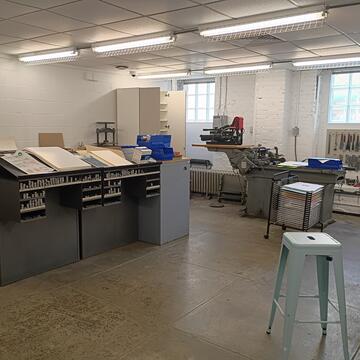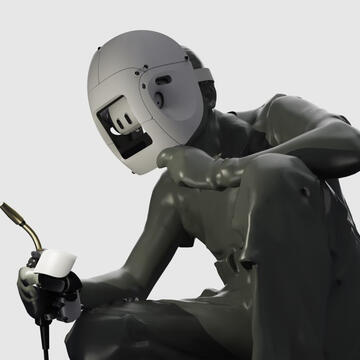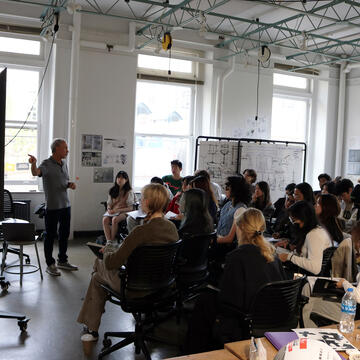
School of Design Labs
The School of Design has an exciting array of labs for faculty and students to engage in, work in and create in. In Design, there are two types of labs - Labs where students do work and Labs where investigation and exploration are done. Learn more about these remarkable spaces and what they hold for future Designers.

2D Lab
The 2D Lab is a hands on work space. Open Thursdays and Fridays on the B level of Margaret Morrison Carnegie Hall the 2D Lab is dedicated to exploring the art of 2D Design including thee letterpress, screen printing, risograph printing, paper making, digital printing & book making. It is a place where students can learn the foundation of design while experimenting in all things print.

Advanced 3D Prototyping Lab
The Advanced 3D Prototyping Lab is where Design students use equipment and material to perform experiments to answer questions that cannot be confirmed with drawing or conversation. This Lab, located in Porter Hall, serves as both a teaching lab and a digital 3d printing and laser cutting service bureau. Students are supported with official courses, as necessary retraining, and some of the most open office hours in all of College of Fine Arts.
Under one roof, students will find fine woodworking equipment, modern CNC woodworking, both analog & digital form giving capabilities, soft goods equipment, soldering, painting & casting, photography & rendering, laser cutting, 3D printing, and gifted people with great deal of knowledge and culture that are highly tied to School of Design pedagogy.

hyperSENSE: Embodied Computations Lab
This lab mainly investigates - How do designed interactions with computational technologies shape us and how do we shape them?
The lab connects teaching and research through blending the physical and digital realms to design embodied human-computer interactions that are situated within different contexts, skill-levels, environments, and cultures. The foundation of the research can be understood as: (1) investigating embodied human-AI co-creation in craft-based practices, (2) augmenting spatial experiences through extended reality, and (3) advancing interaction design education into the realms of embodied and spatial experiences. A sample of the projects can be found on my lab’s website. https://embodiedcomputations.org/
The lab works with students from all years and collaborate with students and professors across campus, including architecture, robotics and HCII.

Learning Environments Lab
The Learning Environment Lab is home to a multidisciplinary team of researchers studying physical and online environments that support learning experiences. The Learning Environments Lab has ongoing collaborations with faculty and PhD students both in the School of Design and HCII, as well as visiting scholars from other universities and the private sector.
The Learning Environments Lab brings multidisciplinary thinkers who bring their expertise to tackle concepts that we could not do individually. It is an inclusive and supportive place to learn together and do incredible work.

Physical Computing Lab
The lab provides the basic physical computing components and tools for integrating technology in tangible and physical projects. It also houses Extended reality headsets that anyone can borrow. Examples of projects below:
- Serentea: An ambient table display that responds to guests' subtle behaviors.
- Investigating air as an interaction design medium.
- Jambo: A working, spatial music instrument that enables riders to compose music based on their skating.

Relational Spatiality Lab
Relational Spatiality is a research studio at Carnegie Mellon University’s School of Design. Our work explores how spatial interactions—defined through elements such as location, proximity, orientation, locomotion, and configuration—can be leveraged to shape experiences of physical closeness, where technology supports everyday activities by connecting people with the objects and others they engage with in physical settings.
Drawing from interaction design (IxD), human-computer interaction (HCI), and architecture, we develop pedagogical tools and room-scale prototypes that foster co-presence, social connection, and tangible engagement in co-located environments.

Smillie Lab
Smillie Lab is a legendary space in Carnegie Mellon University's School of Design. Students in Smillie Lab can find specialty printers, photography space, and state of the art computing power for all of a students' image generation needs.

Spatial Experiences Lab
This is not a "research lab" but a educational resource for students, faculty, and staff to ideate, prototype, and test interactions, media, and physical designs that require a large space. In general, the lab is used as part of a course setting (studio or lab course).
The lab is an empty white box (20 x 30 x 12-foot) instrumented with computers, motion-tracking cameras, projectors, and speakers that can be integrated together to provide computational and input/output capabilities to physical objects, walls, and floors.
Students can find motion tracking tools, digital projectors, spatial audio (Wavefield Synthesis), and IoTs (ESP32s). Motive and Unity software are integrated to design and implement the interactions in a digital 3D environment matching the coordinate system of the physical space.